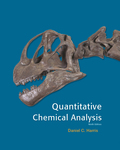
(a)
Interpretation:
The elution volume of excluded molecules should be calculated.
Concept introduction:
Molecular exclusion chromatography:
The molecules are separated by its size in chromatographic separation is known as molecular exclusion chromatography.
In this chromatography, the large molecules are eluted first then small molecules are separated.
The elution volume is directly proportional to the molar mass of the molecule so it is called as gel filtration or permeation chromatography.
Hydrophobic interaction chromatography:
The substance, which is repels the water is known as hydrophobic substance. In Hydrophobic interaction chromatography, the stationary phase is hydrophobic substance.
In the chromatography, the molecule is interact with stationary phase of the column and the solubility of molecule, which is going to separate is decreasing salt concentration of reagent ti increasing solubility molecule.
(a)
Explanation of Solution
To calculate the elution volume of excluded molecules.
Given,
Column diameter is
Column length is
Occupation of gel particles is
Occupation of pores is
The volume between particles occupies is
In then affinity column chromatography, only the bonded molecule is remains in the column rest of other are eluted so the eluted volume is equal to the volume used in the elution of excluded molecules.
Total volume of the column is,
The volume of elution of excluded molecules is equal to the
Therefore, the volume of elution volume of excluded molecules is
The elution volume of excluded molecules was calculated.
(b)
Interpretation:
The elution volume of small molecules should be calculated.
Concept introduction:
Molecular exclusion chromatography:
The molecules are separated by its size in chromatographic separation is known as molecular exclusion chromatography.
In this chromatography, the large molecules are eluted first then small molecules are separated.
The elution volume is directly proportional to the molar mass of the molecule so it is called as gel filtration or permeation chromatography.
Hydrophobic interaction chromatography:
The substance, which is repels the water is known as hydrophobic substance. In Hydrophobic interaction chromatography, the stationary phase is hydrophobic substance.
In the chromatography, the molecule is interact with stationary phase of the column and the solubility of molecule, which is going to separate is decreasing salt concentration of reagent ti increasing solubility molecule.
(b)
Explanation of Solution
To calculate the elution volume of excluded molecules.
Given,
Column diameter is
Column length is
Occupation of gel particles is
Occupation of pores is
The volume between particles occupies is
In then affinity column chromatography, only the bonded molecule is remains in the column rest of other are eluted so the eluted volume is equal to the volume used in the elution of excluded molecules.
Total volume of the column is,
The volume of small of excluded molecules is equal to the
Therefore, the volume of elution volume of small molecules is
The elution volume of small molecules was calculated.
(c)
Interpretation:
Elution of polyethylene glycols from polystyrene resin in HPLC should be explained.
Concept introduction:
Molecular exclusion chromatography:
The molecules are separated by its size in chromatographic separation is known as molecular exclusion chromatography.
In this chromatography, the large molecules are eluted first then small molecules are separated.
The elution volume is directly proportional to the molar mass of the molecule so it is called as gel filtration or permeation chromatography.
Hydrophobic interaction chromatography:
The substance, which is repels the water is known as hydrophobic substance. In Hydrophobic interaction chromatography, the stationary phase is hydrophobic substance.
In the chromatography, the molecule is interact with stationary phase of the column and the solubility of molecule, which is going to separate is decreasing salt concentration of reagent ti increasing solubility molecule.
(c)
Explanation of Solution
To calculate the elution volume of excluded molecules.
Given,
Column diameter is
Column length is
Occupation of gel particles is
Occupation of pores is
The volume between particles occupies is
In then affinity column chromatography, only the bonded molecule is remains in the column rest of other are eluted so the eluted volume is equal to the volume used in the elution of excluded molecules.
Total volume of the column is,
The volume of elution of excluded molecules is equal to the
Therefore, the volume of elution volume of excluded molecules is
The volume of small of excluded molecules is equal to the
Therefore, the volume of elution volume of small molecules is
Hence, the solute is absorbed on the polystyrene resin or otherwise they are eluted between
The elution volume of polyethylene glycols are
From the above calculations the given column size and elution volume of column, the molecules are eluted between
Therefore, polyethylene glycols are must adsorbed on the polystyrene resin and they are eluted between
Elution of polyethylene glycols from polystyrene resin in HPLC was explained.
Want to see more full solutions like this?
Chapter 26 Solutions
Quantitative Chemical Analysis
 ChemistryChemistryISBN:9781305957404Author:Steven S. Zumdahl, Susan A. Zumdahl, Donald J. DeCostePublisher:Cengage Learning
ChemistryChemistryISBN:9781305957404Author:Steven S. Zumdahl, Susan A. Zumdahl, Donald J. DeCostePublisher:Cengage Learning ChemistryChemistryISBN:9781259911156Author:Raymond Chang Dr., Jason Overby ProfessorPublisher:McGraw-Hill Education
ChemistryChemistryISBN:9781259911156Author:Raymond Chang Dr., Jason Overby ProfessorPublisher:McGraw-Hill Education Principles of Instrumental AnalysisChemistryISBN:9781305577213Author:Douglas A. Skoog, F. James Holler, Stanley R. CrouchPublisher:Cengage Learning
Principles of Instrumental AnalysisChemistryISBN:9781305577213Author:Douglas A. Skoog, F. James Holler, Stanley R. CrouchPublisher:Cengage Learning Organic ChemistryChemistryISBN:9780078021558Author:Janice Gorzynski Smith Dr.Publisher:McGraw-Hill Education
Organic ChemistryChemistryISBN:9780078021558Author:Janice Gorzynski Smith Dr.Publisher:McGraw-Hill Education Chemistry: Principles and ReactionsChemistryISBN:9781305079373Author:William L. Masterton, Cecile N. HurleyPublisher:Cengage Learning
Chemistry: Principles and ReactionsChemistryISBN:9781305079373Author:William L. Masterton, Cecile N. HurleyPublisher:Cengage Learning Elementary Principles of Chemical Processes, Bind...ChemistryISBN:9781118431221Author:Richard M. Felder, Ronald W. Rousseau, Lisa G. BullardPublisher:WILEY
Elementary Principles of Chemical Processes, Bind...ChemistryISBN:9781118431221Author:Richard M. Felder, Ronald W. Rousseau, Lisa G. BullardPublisher:WILEY





